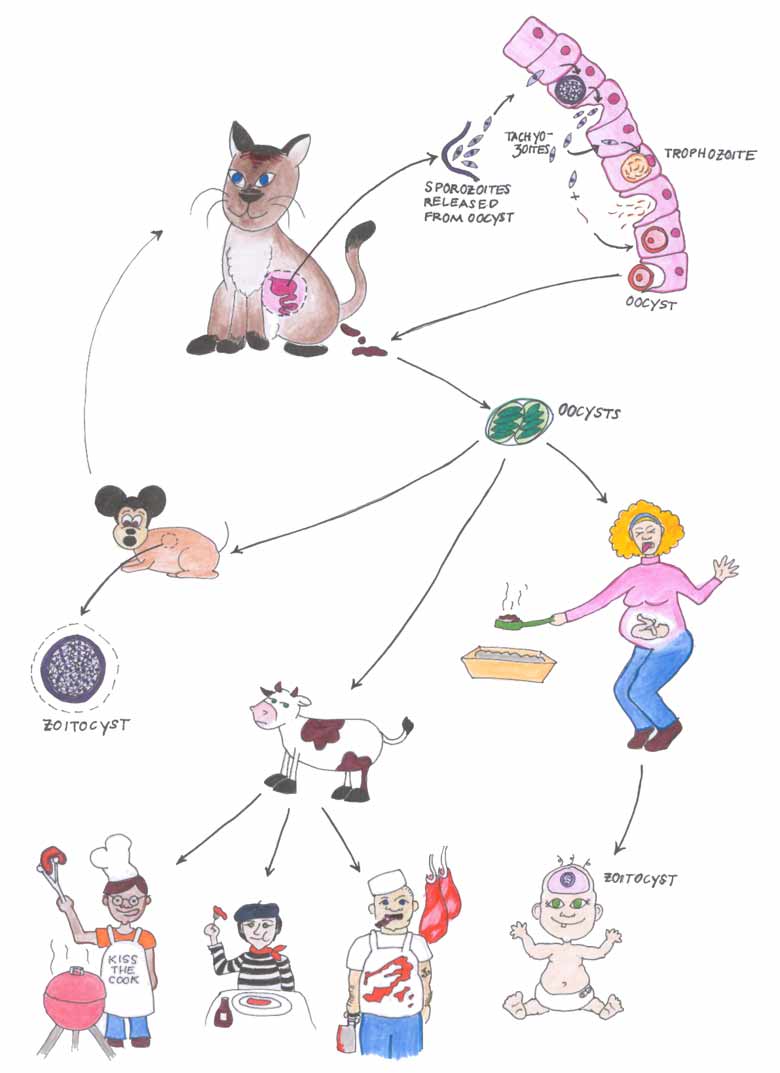
Toxoplasma gondii was first discovered in a north African rat, the gondi in the early part of the 20th century. During the early 20th century, the biology of Toxoplasma was ill-understood with mid-20th century texts including it with either the fungal groups or protozoa depending on the author. With the advent of effective electron microscopy in the 1960s, the apical complex was visualized, forever placing it within the phylum Apicomplexa of the Kingdom Protista. It is an intracellular parasite of numerous tissues, particularly skeletal muscle, intestine and nervous tissue. The cycle includes an intestinal phase (enteroepithelial) in domestic cats and other felines and an extraintestinal phase in cats and non-cats. The extraintestinal phase may occur in a number of non-cat hosts, such as humans, where the disease toxoplasmosis is evident. Rats and other mammals, including food animals such as pigs, cattle and sheep are commonly involved in the extraintestinal phase of the life cycle. Humans become infected through ingestion of poorly cooked meat and also via sporocyst ingestion from cat feces. Infected rats may be predated by cats, perpetuating the life cycle. Oocysts fragment into two sporocysts, each of which contain 4 sporozoites. Ingested sporocysts, zoitocysts and occasionally tachyzoites may lead to intestinal infections in cats. The extraintestinal phase of the life cycle often occurs when zoitocysts containing bradyzoites are ingested, though ingested tachyzoites or sporocysts may also lead to infections in non-cats, most notably humans. The above diagram warns that pregnant women should never be given the job of cleaning the pet cat's litter box. Should a women who was Toxoplasma-free before her pregnancy, become infected for the first time during a pregnancy, the chances of her delivering a congenitally-infected child are very high, about 45% of such pregnancies. About 3500 children are born each year in the US with congenital toxoplasmosis. Tachyzoites are the active dividing phase during acute infections and may enter the brain, heart or skeletal muscles where they multiply more slowly as bradyzoites. In those tissues, bradyzoite clusters become encysted and are known as zoitocysts. The cyst formation coincides with developing immune responses which usually confer permanent immunity in that host. In immunoincompetent individuals such as AIDS victims, bradyzoites may emerge from zoitocysts and wreak new havoc. Toxoplasmosis is one of the most common opportunistic diseases associated with AIDS. Backyard barbecuers inadequately cooking meat, steak tartare (raw beef) commonly eaten in France and also by gourmets and intrepid diners here in the US, and butchers through hand contamination, represent significant human sources of infection. Cats which are feral or even the pet outdoor cat are prime sources of infection. Any cat which eats rodents should be considered a potential source of infection, even though it may only "shed" sporocysts for a brief period of time after infection.